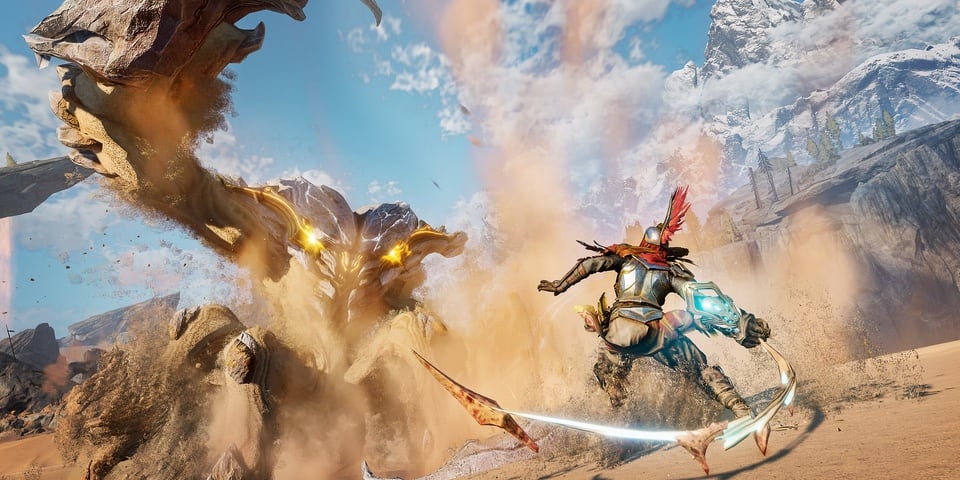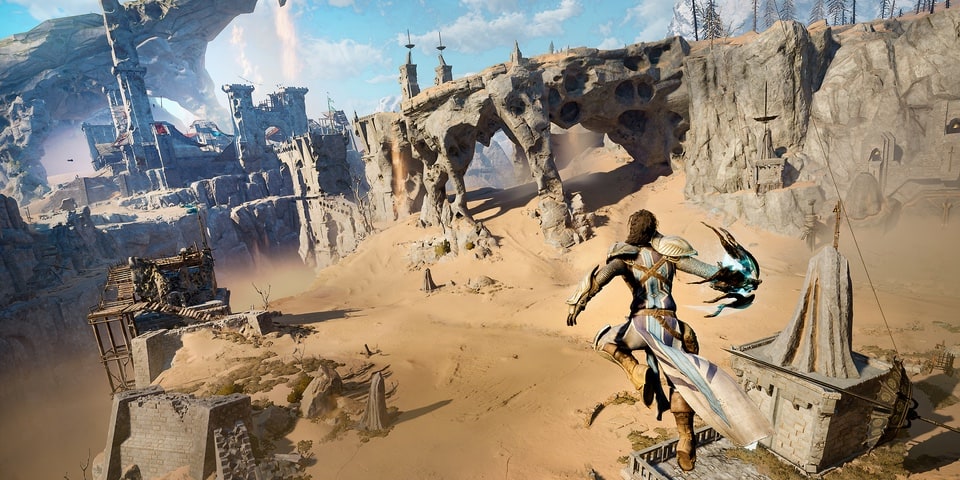If you’re coming to Atlas Fallen expecting Deck13 to have continued down the souls-like path of their The Surge series, prepare to be surprised. Atlas Fallen does have some similarities to their previous work – you can target and destroy specific enemy body parts in combat – but is otherwise is a bit of a departure, focused more on spectacular fights against giant monsters with a huge axe than it is on careful, measured combat. It’s more Darksiders than it is Dark Souls, basically, but with weapons that get bigger the longer you use them.
The game begins (after a brief prologue) with you as a slave-like Unnamed, a part of an expedition that’s gone just a little bit wrong due to a run-in with huge, magical wraiths. After you manage to annoy the expedition’s Captain Morrath, you get sent out into the surrounding wilderness to find a thief, but instead happen to find a magical, glowing gauntlet with an entity inside it. Naturally this gauntlet allows you to fight wraiths, and you’ll soon find yourself liberating a land from a corrupt god as you battle and quest your way across various desert regions.
There are a few interesting touches, such as the inclusion of a giant ominous statue floating on the horizon, watching over you at all times, getting bigger as you get closer, and occasionally getting angry and teleporting you somewhere to fight some monsters, but the story as a whole is a bit forgettable. It’s also often delivered through dialogue that just skips over any questions and prompting – the entity in the gauntlet sometimes just suddenly remembers things or knows things with little to no further explanation. The bigger issue is the flat voice acting, and some characters’ voices don’t seem to fit them somehow. The main character is apparently a slave, but clearly has the accent of a nobleman, for example, which is a bit of a distraction when you’re trying to stay immersed in a story that’s not quite deep enough.

So it’s a good thing that the combat, which is the real focus of Atlas Fallen, has some engaging ideas running through it. You’ll find yourself fighting a selection of monsters ranging from small (relatively speaking) cloaking dog-like creatures through to huge, burrowing snakes, giant crabs, flying creatures and other, harder-to-describe monstrous things. Thankfully, your gauntlet does more than keeping your hand warm and snug, as it can summon weapons, specifically, the Dunecleaver axe, the Knuckledust for punching really hard, and the Sandwhip, which is basically knives on a sandy string.
As you fight, you gain momentum which fills up a bar on the bottom left of the screen. This bar has three segments and as your momentum builds into each section your weapons will increase in size. Your Sandwhip becomes a whirlwind on sandy knives and your axe reaches a Final Fantasy-level of absurd size.
This is good when your enemies are so large and persistent. They’re damage sponges (no bullets here) and you’re required to destroy multiple body parts, so they can take a little time. They also like to summon other enemies repeatedly throughout combat, and sometimes they just turn into tornados. So you’ll want to keep your sandskin (parry) and dodge buttons handy and keep away from any blue attacks, which can’t be parried and will drain your momentum in addition to damaging you.
You can also spend your acquired momentum to shatter an enemy, dealing very high damage in the process, but you’ll have to weigh that up against the bigger weapons and all your other abilities. As your momentum fills up, your abilities start to activate as well, with active abilities usable on a simple cooldown while others have passive benefits.

The range of possibilities here is wild, allowing you to customise your moves and buffs until your heart’s content. There are active abilities that summon balls of energy to charge up and launch, Spirit Bomb-style, others that dash to enemies to attack and interrupt quickly, one tier 3 ability slows enemies in a wide radius, another deals high damage and instantly refreshes its cooldown if it kills an enemy or destroys a body part.
Seriously, the variety on offer here is not to be understated, although it does seem like a few of them are either dull or miss the point, such as one active ability that simply stops enemies from summon smaller enemies for fifteen whole second which, whilst possibly useful if it didn’t have the timer, would still be boring. Then there’s the one that drops your health to 1 whilst massively increasing your damage, which is clearly designed for players who are way better at games than I will ever be. Despite a few that are little more miss than hit, there are still a tonne of options here to customise your build to your favourite method of beating enemies down.
You can share the adventure with another player in two player co-op, which certainly helps with some of the battles you face – who doesn’t like having someone revive them instead of needing to load a checkpoint? That said, there’s seemingly some oddities with the game scaling to match players from different stages of the game. It’s great to have the option, though seemed to give Ade a few abilities he hadn’t unlocked yet. Not that he was complaining…

However there are a few issues with combat. Firstly, having large enemies summoning smaller ones repeatedly in combat is a bit cheap and frustrating, and most of the larger enemies in this game do this. They also have a bad habit of respawning all around you shortly after you’ve killed the last group. The bigger issue is really that there is a severely limited amount of enemies, so you’ll find yourself fighting a giant crab a good fifty times in this game, and the same with all the other enemies.
Speaking of the giant crab, it can turn into a very damaging tornado for some reason with only a split second warning that can be very hard to spot amidst all the chaos, resulting in your tremendously powerful character taking an absurd amount of damage and having to run away until it turns back into a crab. It’s just frustrating to not be able to fight something because it turned itself into an area of effect attack, and it really breaks the flow of the fight to just pick up your three storey tall axe and run away. Lock on can be a bit fiddly as well, sometimes just refusing to refocus on the right enemy because it’s too busy switching between the body parts of a big one. Outside of these issues combat is enjoyable and can get pretty intense, it’s just that it outstays its welcome before you reach the end of the story.

Exploring the world can be really enjoyable, with the gauntlet giving you the ability to ski across sand, double jump and triple air dash, which are satisfying to chain together (even if the air dash could do more to preserve the sense of speed). The world looks fantastic while you’re gliding across it, but sooner or later you get tired of the sand – it’s coarse, rough, irritating, etc. etc. It’s all desert with some areas of foliage or devastation, and rarely deviates from that. When it does, it can be breathtaking – a sunken city literally made me gasp when I first saw its ramshackle and uneven design – but it’s rare.
Sadly the exploration is not well rewarded, and you’ll end up with an inventory full of trinkets to sell in bulk at the next shop you find. The game world is littered with fairly generic open world activities, like following a light between pillars to a time limit, viewpoints, boring platforming challenges on floating platforms to a timer, just tonnes of these dotted about the place. One of the regions has thirteen of the light pillar tasks. These could not be more uninspired, I don’t recall the in-world explanation for why there are connected pillars connected that point to a chest, if there ever was one.


